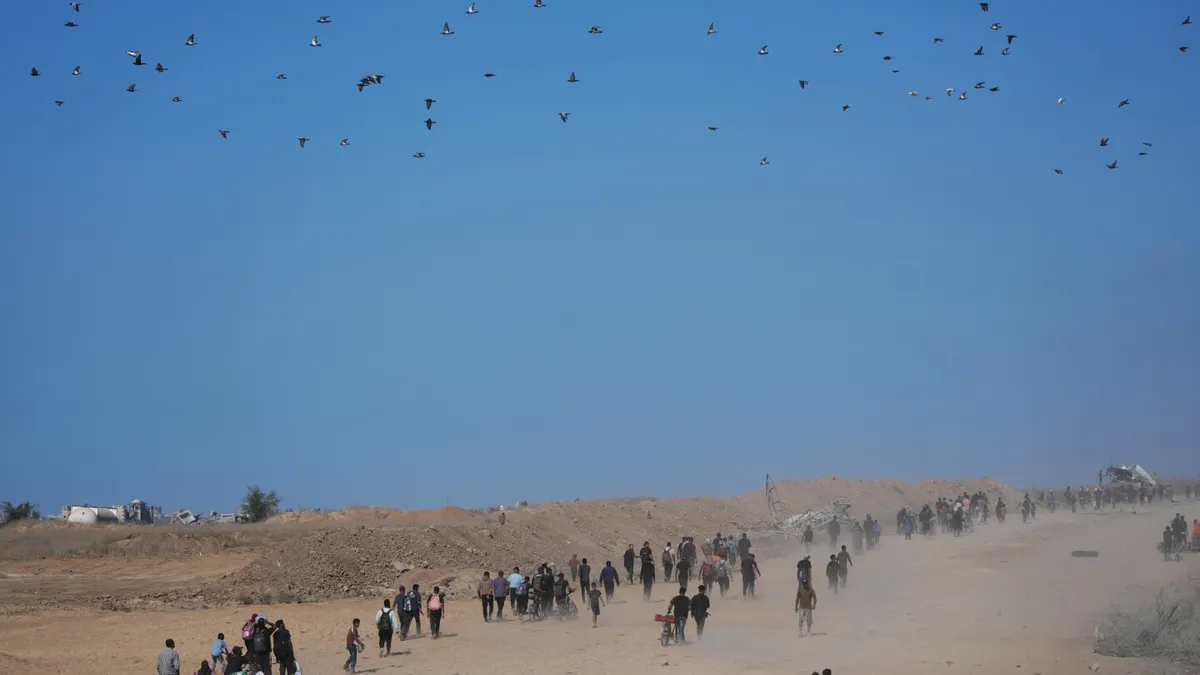
On Friday, a ceasefire between Israel and Hamas was officially implemented in the Gaza Strip, following a significant decision by Israel’s Cabinet to pause hostilities and negotiate an exchange of remaining hostages for Palestinian prisoners. This pivotal moment has come after a devastating two-year conflict that has resulted in the loss of tens of thousands of Palestinian lives and left significant portions of Gaza in ruins.
Shortly after the announcement made by the Israeli military at noon local time, tens of thousands of Palestinians began their journey northward from Wadi Gaza. This movement was a response to the ceasefire, which was welcomed after heavy shelling had been reported in various parts of Gaza earlier that morning. Following the ceasefire's initiation, reports indicated a significant decrease in military bombardment, marking a potential end to the extensive violence.
This ceasefire is not just a temporary halt in fighting; it represents a crucial step towards a broader resolution of a conflict that has destabilized the Middle East. U.S. President Donald Trump’s plan, however, remains laden with uncertainties regarding the disarmament of Hamas and the future governance of Gaza. Prime Minister Benjamin Netanyahu emphasized the necessity of Hamas's disarmament in a televised statement, asserting that Israel would continue its defensive operations to mitigate threats to its troops.
Netanyahu declared, “If this is achieved the easy way — so be it. If not — it will be achieved the hard way,” illustrating the complexities surrounding the ceasefire agreement. As Israeli military spokesperson Brig. Gen. Effie Defrin noted, troops successfully withdrew to their deployment lines within hours of the ceasefire taking effect, reflecting a strategic shift in Israel's military posture.
A palpable sense of urgency characterized the movement of displaced residents returning to their homes to assess the damage. Many were met with scenes of utter destruction. Fayez AlMajdoub, a displaced individual from northern Gaza, expressed a common sentiment, stating, “We want to go back,” while others echoed similar feelings of loss and uncertainty.
In Khan Younis, residents returned only to discover wrecked buildings and debris. Fatma Radwan, another displaced person, lamented, “There was nothing left. Just a few clothes, pieces of wood, and pots.” The returnees faced the grim reality of their homes being unrecognizable, with many still searching for loved ones believed to be trapped under the rubble.
The conflict, which escalated dramatically after Hamas militants infiltrated Israel on October 7, 2023, has resulted in over 67,000 Palestinian deaths, according to Gaza’s Health Ministry. This figure includes a significant number of women and children, reflecting the dire humanitarian crisis in the region. The war's impact has extended beyond borders, igniting global protests and raising allegations of genocide, which Israel has consistently refuted.
As part of the ceasefire agreement, Israeli troops have repositioned within Gaza, and plans are in place for the release of approximately 48 hostages still held captive, with expectations that around 20 of them are alive. In return, Israel is set to release about 2,000 Palestinian prisoners. However, notable figures such as Marwan Barghouti, a prominent Palestinian leader, remain excluded from this exchange.
Khalil al-Hayya, a senior Hamas official, stated that all women and children in Israeli prisons would be released, with the exchange process anticipated to commence as early as Sunday night, according to various officials involved in the negotiations.
The ceasefire agreement also entails the reopening of five border crossings, including the Rafah crossing to Egypt, facilitating much-needed humanitarian aid into Gaza, which is currently facing famine conditions. Additionally, U.S. officials have signaled that approximately 200 troops will be deployed to Israel to support international efforts overseeing the ceasefire and reconstruction.
While the Trump administration's plan calls for Israel to maintain a military presence in Gaza indefinitely, it also proposes a role for the Palestinian Authority, contingent upon extensive reforms. However, the future of a Palestinian state remains uncertain, with ongoing resistance from Israeli leadership.
As this complex situation continues to unfold, the hope for lasting peace remains fragile, underscored by the pain and suffering experienced by countless families. The challenges ahead are immense, but the recent ceasefire offers a glimmer of hope for a population yearning for stability and peace.